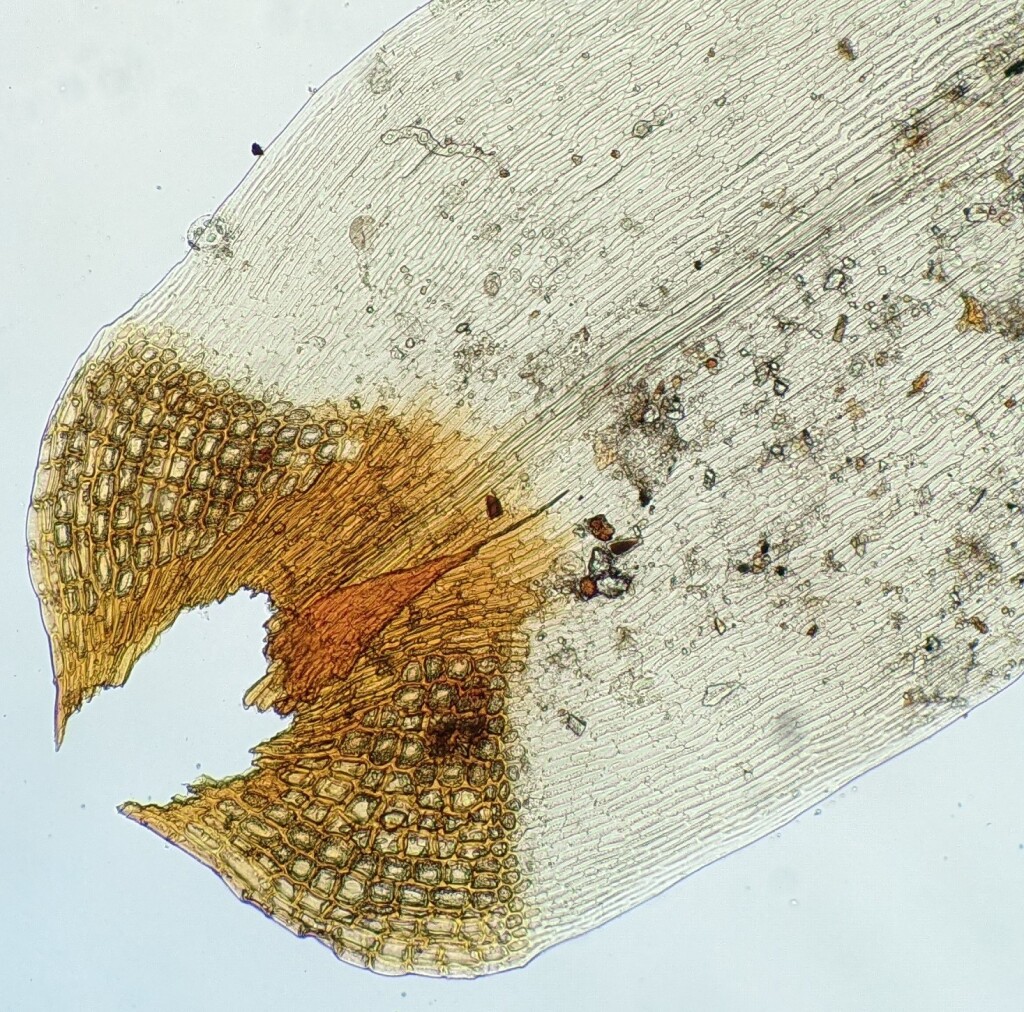Dicranoloma robustum
(Hook.f. & Wilson) ParisAsexual propagules absent. Cushions or turfs 2–12 cm tall on soil, rocks, logs or tree bases. Stems simple or branched, brown, with sparse pale rhizoids; central strand present. Leaves erecto-patent to falcate-secund, barely altered when dry, lanceolate, 6.4–24 mm long, 0.7–2.1 mm wide, canaliculate; apex gradually long-acuminate, often almost entirely consisting of costa in upper part, fragile, sometimes detached; costa distinct, subpercurrent to excurrent, abaxially mostly with scattered teeth toward apex; margin serrulate in apical 1/10–2/3, entire below, plane or sometimes weakly undulate, with a border of 1–5 (–7) rows of cells extending to between ¼ length of leaf and serrulate part of margin; lamina cells in apical half oblong to linear, 13–140 μm long, 5–16 μm wide; lamina cells in basal half elongate to linear, 35–180 μm long, 6–20 μm wide; alar cells quadrate, rectangular or polygonal, 15–93 μm long, 10–51 μm wide, not inflated, with yellowish to orange-brown walls. Seta solitary, 13.5–33.5 mm long, reddish, smooth. Capsule inclined to vertical, cylindric, curved, 1.5–4 mm long. Operculum obliquely rostrate from conical base, 3–3.2 mm long.
GipP, CVU, GGr, EGL, EGU, WPro, HSF, HNF, OtR, Strz, MonT, HFE, VAlp. New Zealand, sub-Antarctic Islands, southern South America. Also QLD, NSW, ACT and Tas. Widespread along and south of the Great Dividing Range in wet forest and the alpine zone.
Scott and Stone (1976) included D. robustum within the similar D. billarderii. While these two species are closely related, two lineages are resolved in phylogenies based on chloroplast and nuclear DNA sequences, each composed exclusively of populations of each species across their ranges (Stech et al. 2006) demonstrating that they are genetically distinct. There is also a cytological distinction between the two species with a n = 12 chromosome number reported for D. billarderii and n = 7 for D. robustum (Ramsay 1985). Dicranoloma robustum is also the most morphologically variable species of the genus in Australia, varying in plant size, leaf length and width, the extent that the costa is excurrent, ornamentation of the leaf margin and the size and shape of laminal cells (Klazenga 2003). Including D. robustum with D. billarderii would unfavourably create an even more variable species.
 Spinning
SpinningKlazenga, N. (2003). A revision of the Australasian species of Dicranoloma (Bryophyta, Dicranaceae). Australalian Systematic Botany 16: 427–471.
Ramsay, H.P. (1985). Cytological and sexual characteristics of the moss Dicranoloma Ren.. Monographs in Systematic Botany from the Missouri Botanical Garden 11: 93–110.
Scott, G.A.M.; Stone, I.G. (1976). The mosses of Southern Australia. Academic Press, London, New York, San Francisco.
Stech, M.; Pfeiffer, T.; Frey, W. (2006). Molecular relationships and divergence of Palaeoaustral Dicranoloma species (Dicranaceae, Bryopsida). Studies in Austral temperate rainforest bryophytes. Journal of the Hattori Botanical Laboratory 100: 451–464.


